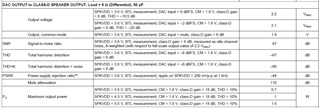Hello,
According to the datasheet, the output voltage of the class-D amplifier is (maximum?) 2.2V RMS.
This gives 0.61W average power on 8 Ohm speaker and 1.21W average power on 4 Ohm speaker. In the datasheet the stated power is the peak one, ie twice less than the average.

Also 2.2V RMS gives 3.11V peak. So, I presume, the output voltage cannot go bigger than the AVDD.
My question:
Why and what is the benefit of powering the Class-D amplifier with 5V? The output voltage cannot go more than AVDD (3.6V max) anyway.
Thank you.


